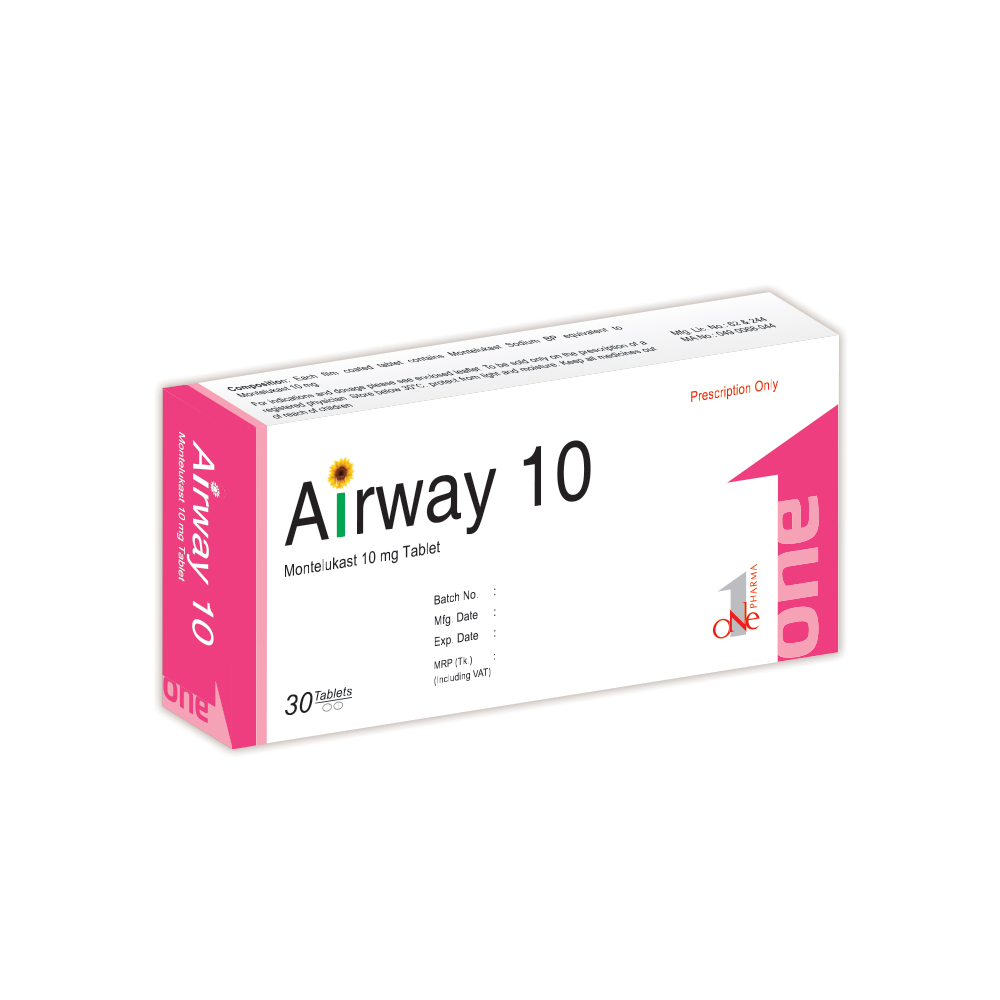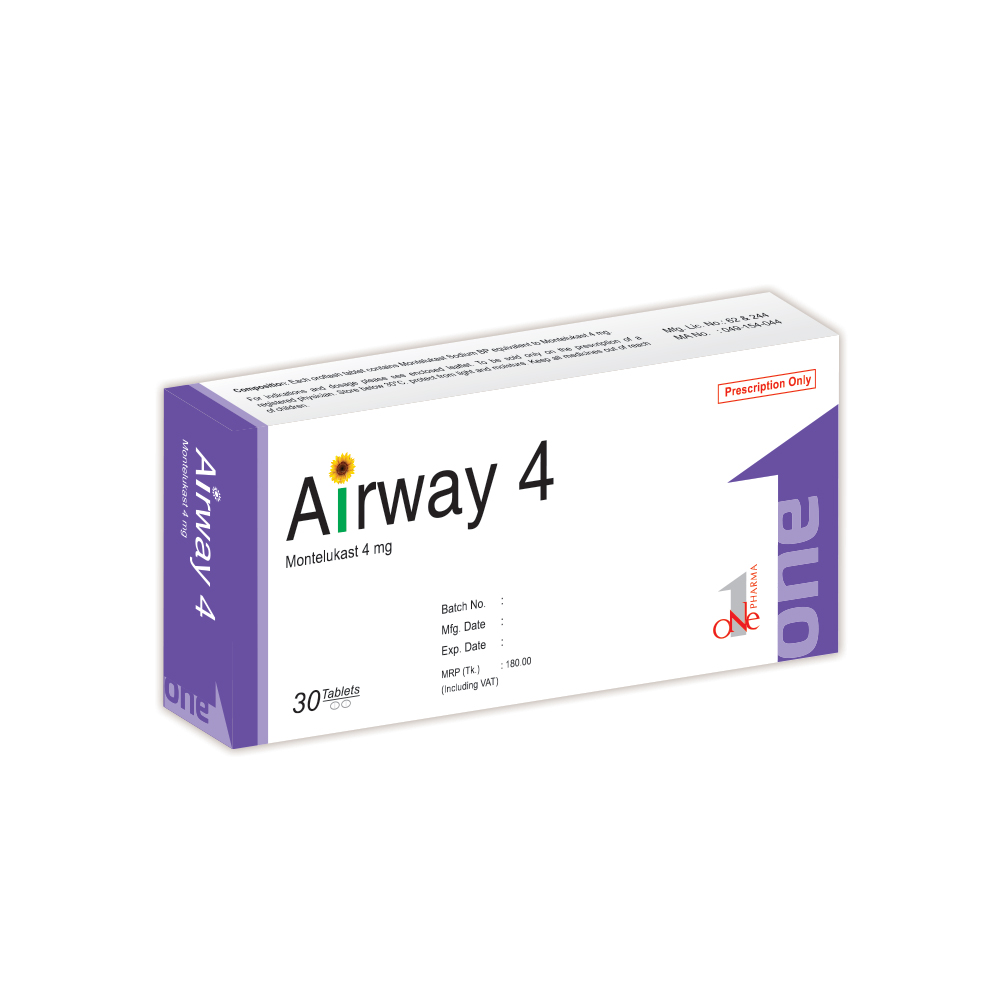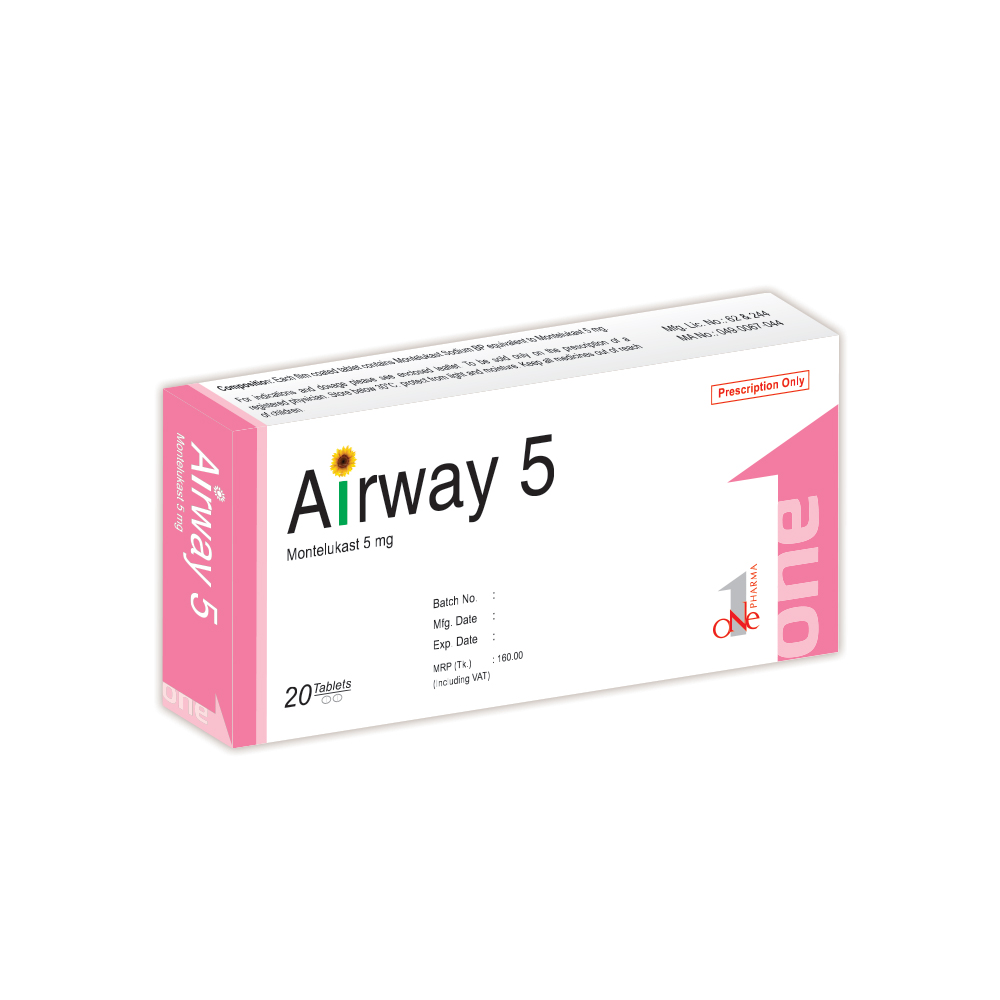







Composition
Airway 4 mg Tablet: Each oroflash tablet contains Montelukast Sodium BP equivalent to Montelukast 4 mg.
Airway 5 mg Tablet: Each film coated tablet contains Montelukast Sodium BP equivalent to Montelukast 5 mg.
Airway 10 mg Tablet: Each film coated tablet contains Montelukast Sodium BP equivalent to Montelukast 10 mg.
Pharmacology
Montelukast is a selective and orally active leukotriene receptor antagonist that inhibits the cysteinyl leukotriene
CysLT1 receptor. Cysteinyl leukotrienes and leukotriene receptor occupation have been correlated with the
pathophysiology of asthma (such as, airway edema, smooth muscle contraction and altered cellular activity
associated with the inflammatory process, which contribute to the signs and symptoms of asthma).
Indication
Montelukast is indicated for the prophylaxis and chronic treatment of asthma in adults and pediatric patients.
Dose and Administration
a) Route of administration: Oral
Dose: Adults (15 years of age or over): 10 mg daily to be taken in the evening.
Children (6-14 years of age): 5 mg daily to be taken in the evening.
Children (6 months to 5 years of age): 4 mg oroflash tablet daily to be taken in the evening.
The safety and efficacy of Montelukast was demonstrated in clinical trials where it was administered in the
evening without regard to the time of food ingestion.
Contra-indication
Montelukast is contraindicated to patients with hypersensitivity to any component of this product.
Warning & Precautions
Montelukast is not indicated for use in the reversal of bronchospasm in acute asthma attacks (in case of status
asthmaticus). Patients with known aspirin sensitivity should continue avoidance of aspirin or other NSAID, while
taking Montelukast. In rare cases, patients on therapy with Montelukast may present with systemic eosinophilia,
sometimes presenting with clinical features of vasculitis consistent with churg-strauss syndrome, a condition
which is often treated with systemic corticosteroid therapy. Physician should be alert to eosinophilia, vasculitic
rash, worsening pulmonary symptoms, cardiac complications, and/or neuropathy presenting in their patients. A
causal association between Montelukast and these underlying conditions has not been established.
Side effect
a) Common: Generally, Montelukast is well-tolerated. Side effects include dizziness, headache, diarrhea,
restlessness, abdominal pain, cough, fever, asthenia, rash and upper respiratory tract infection.
b) Rare: No adequate data are available.
Pregnancy and lactation
Pregnancy: There are no adequate and well-controlled studies of Montelukast in pregnant women. Because
animal reproductive studies are not always predictive of human response, so Montelukast should be used during
pregnancy only if clearly needed.
Lactation: It is not known if Montelukast is excreted in human milk. Because many drugs are excreted in human
milk, so caution should be exercised when Montelukast is given to a nursing mother.
Use in Children & Adolescents
Should be used as per direction of physician.
Drug interaction
a) With Medicine: Montelukast has been administered with other therapies routinely used in the prophylaxis and
chronic treatment of asthma with no appropriate increase in adverse reactions. Cytochrome P-450 inducers:
Although Phenobarbital induces hepatic metabolism, no dosage adjustment for Montelukast is recommended. It is
reasonable to employ appropriate clinical monitoring when potent cytochrome P-450 enzyme inducers, such as
Phenobarbital or Rifampin, are co-administered with Montelukast.
b) With food & others: No adequate data are available.
Overdose
There were no adverse experiences reported in the majority of overdosage reports. The most frequent adverse
experiences observed were thirst, mydriasis, hyperkinesia, and abdominal pain. In the event of overdose, it is
reasonable to employ the usual supportive measures; e.g., remove unabsorbed material from the gastrointestinal
tract, employ clinical monitoring, and institute supportive therapy, if required.
Storage
Store below 30°C. Protect from light and moisture. Keep all medicines out of reach of children.
Packing
Airway 4 mg Tablet: Each box contains 30 (3×10’s) Tablets in Alu-Alu Blister Pack.
Airway 5 mg Tablet: Each box contains 20 (2×10’s) Tablets in Alu-Alu Blister Pack.
Airway 10 mg Tablet: Each box contains 30 (3×10’s) Tablets in Alu-Alu Blister Pack